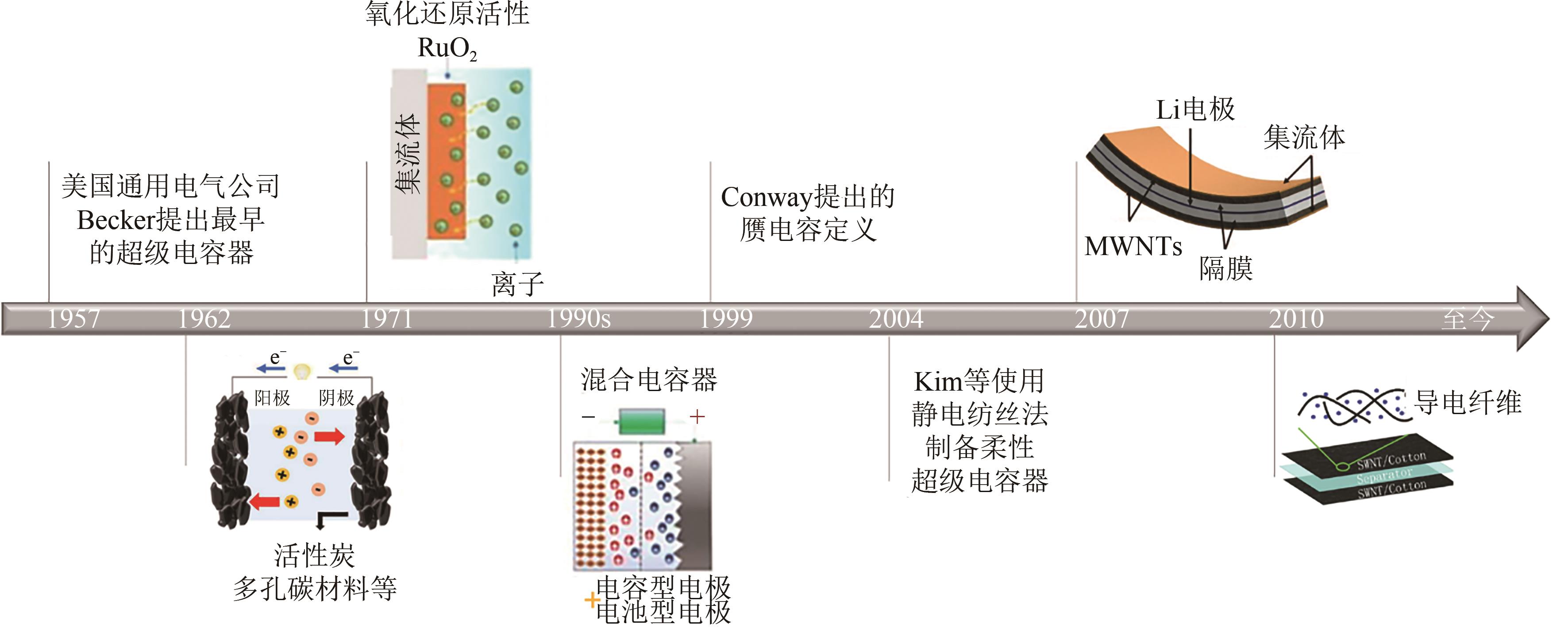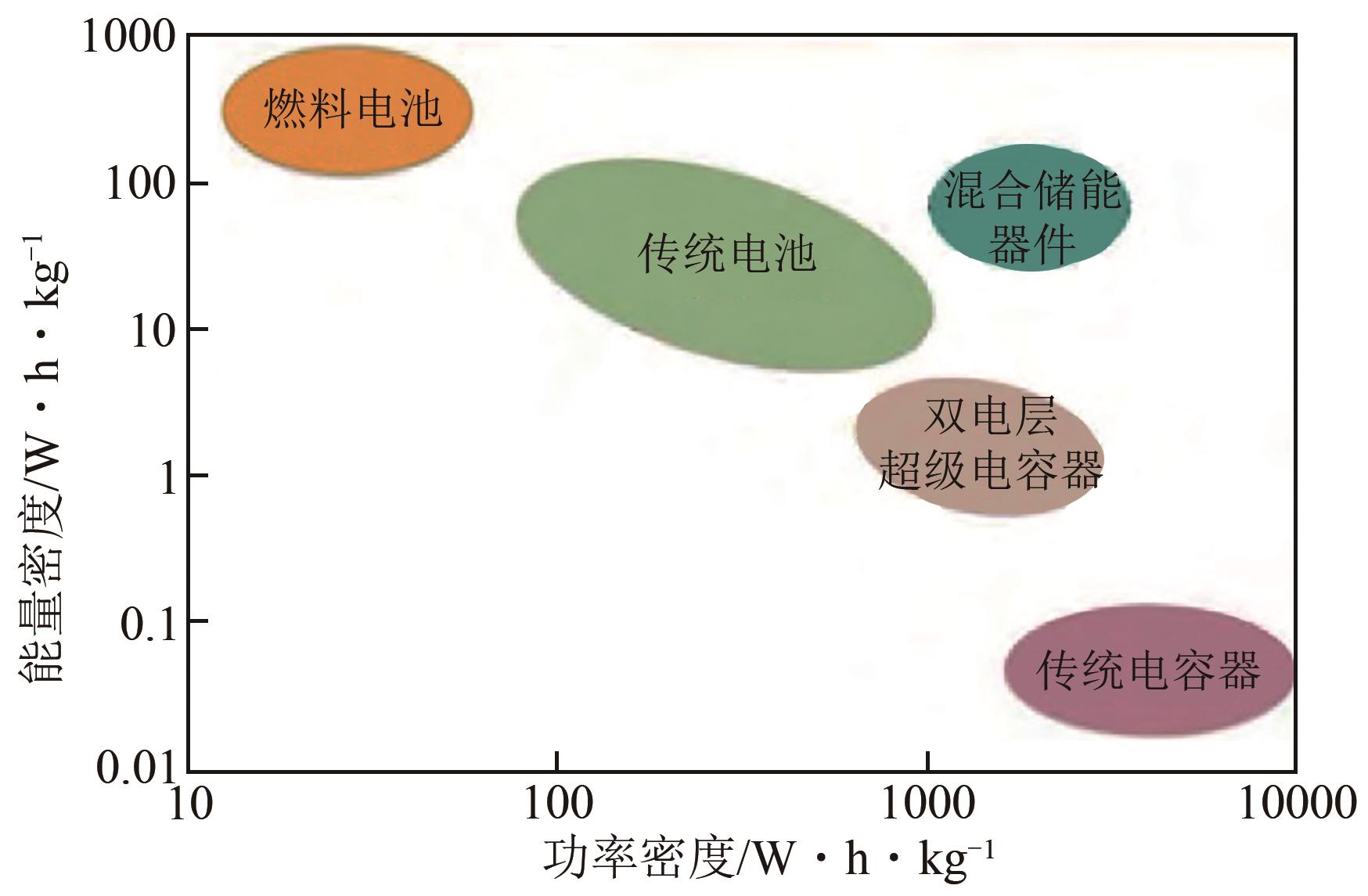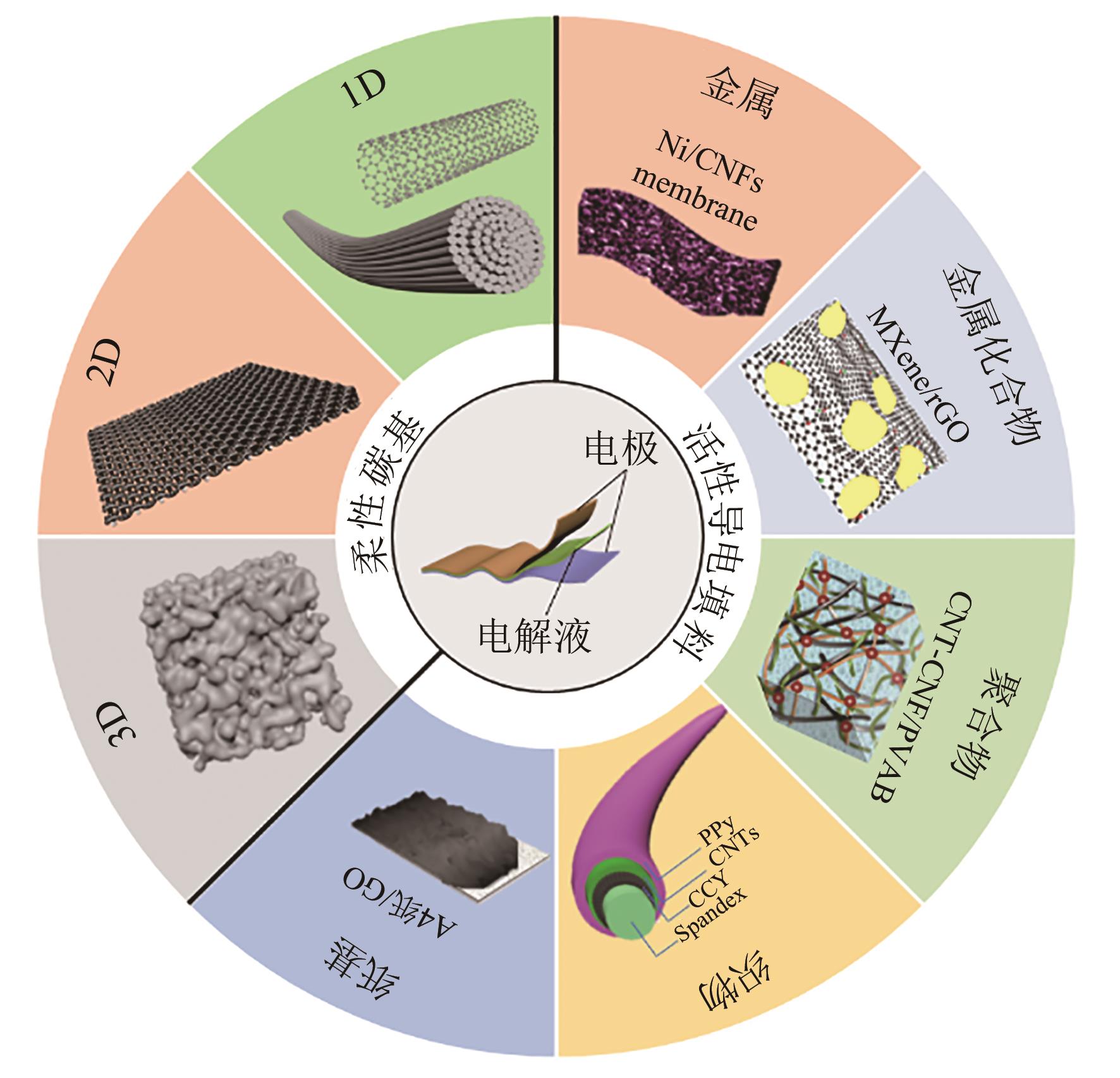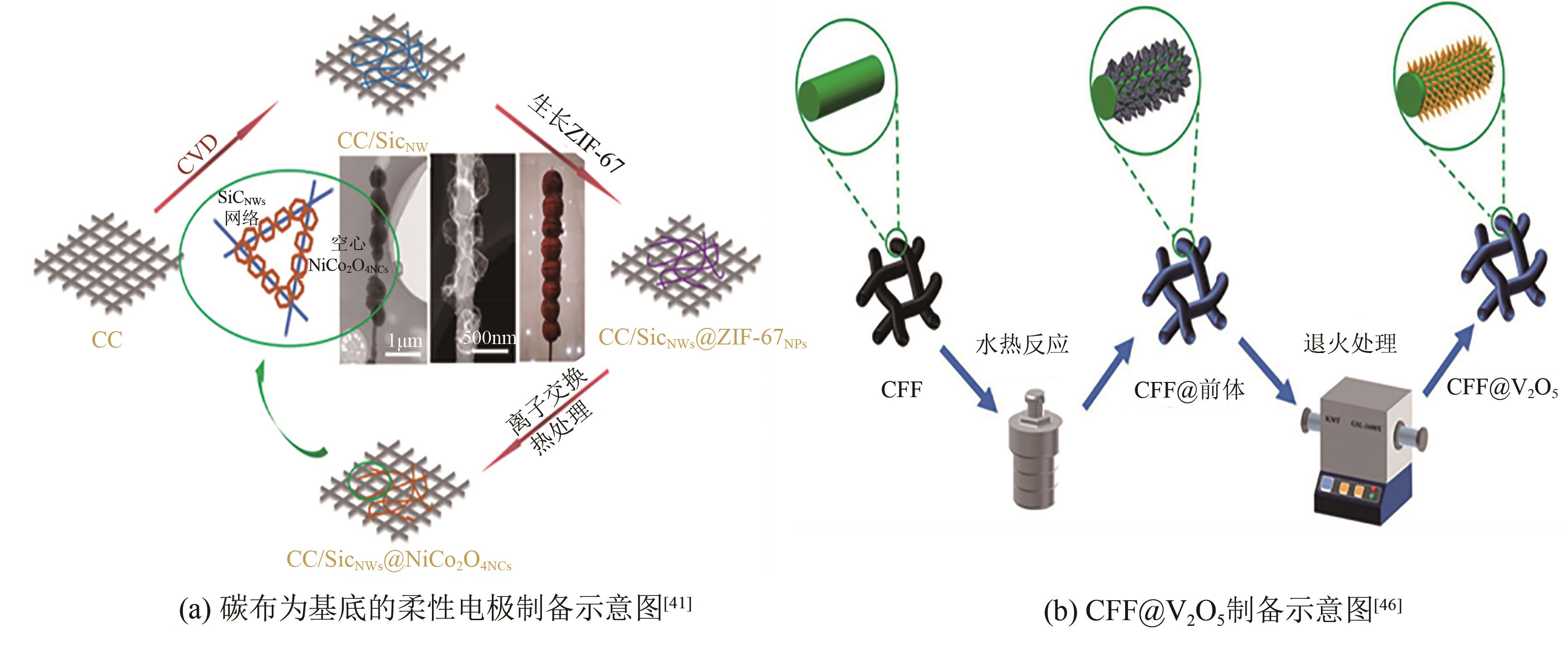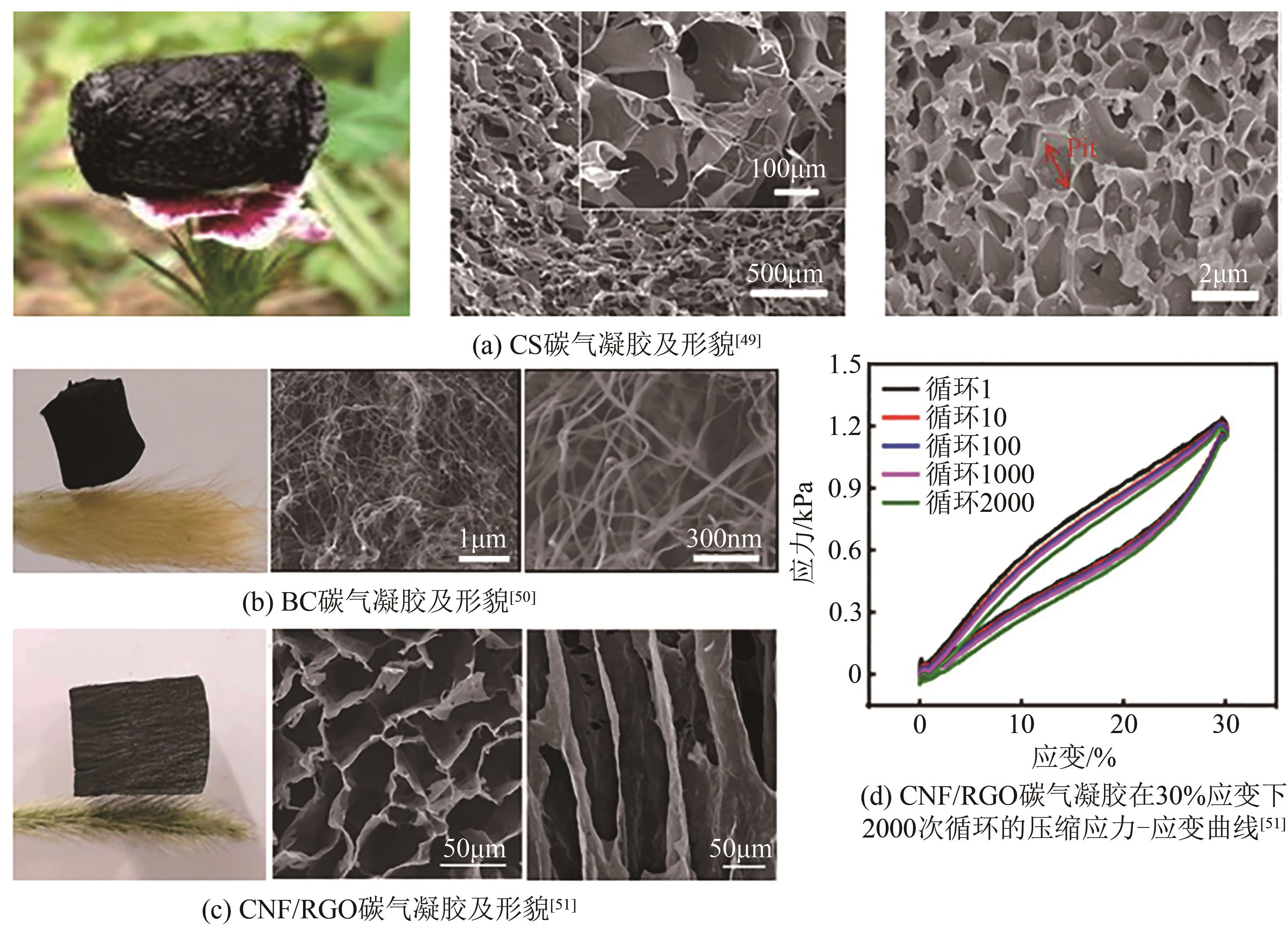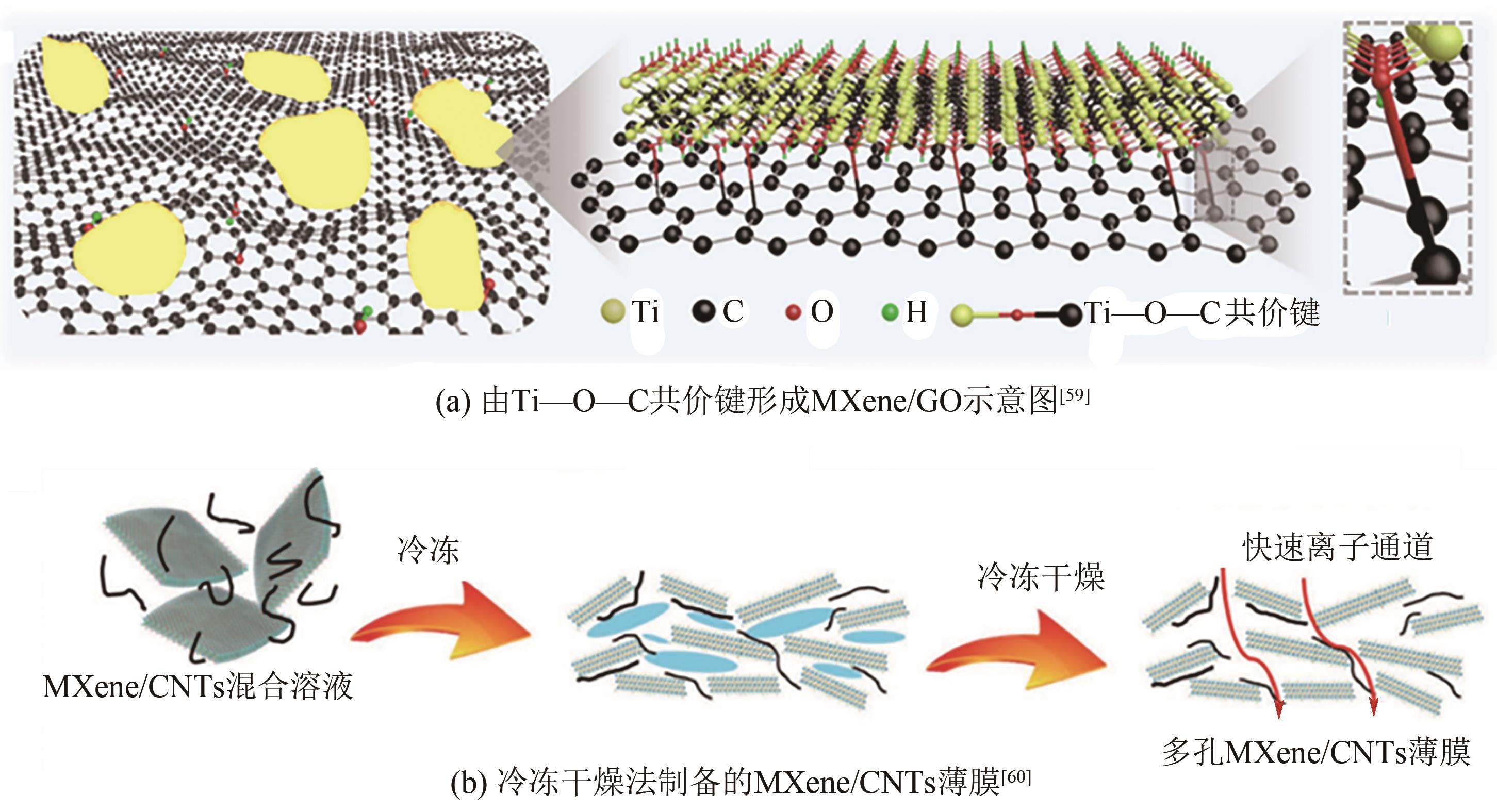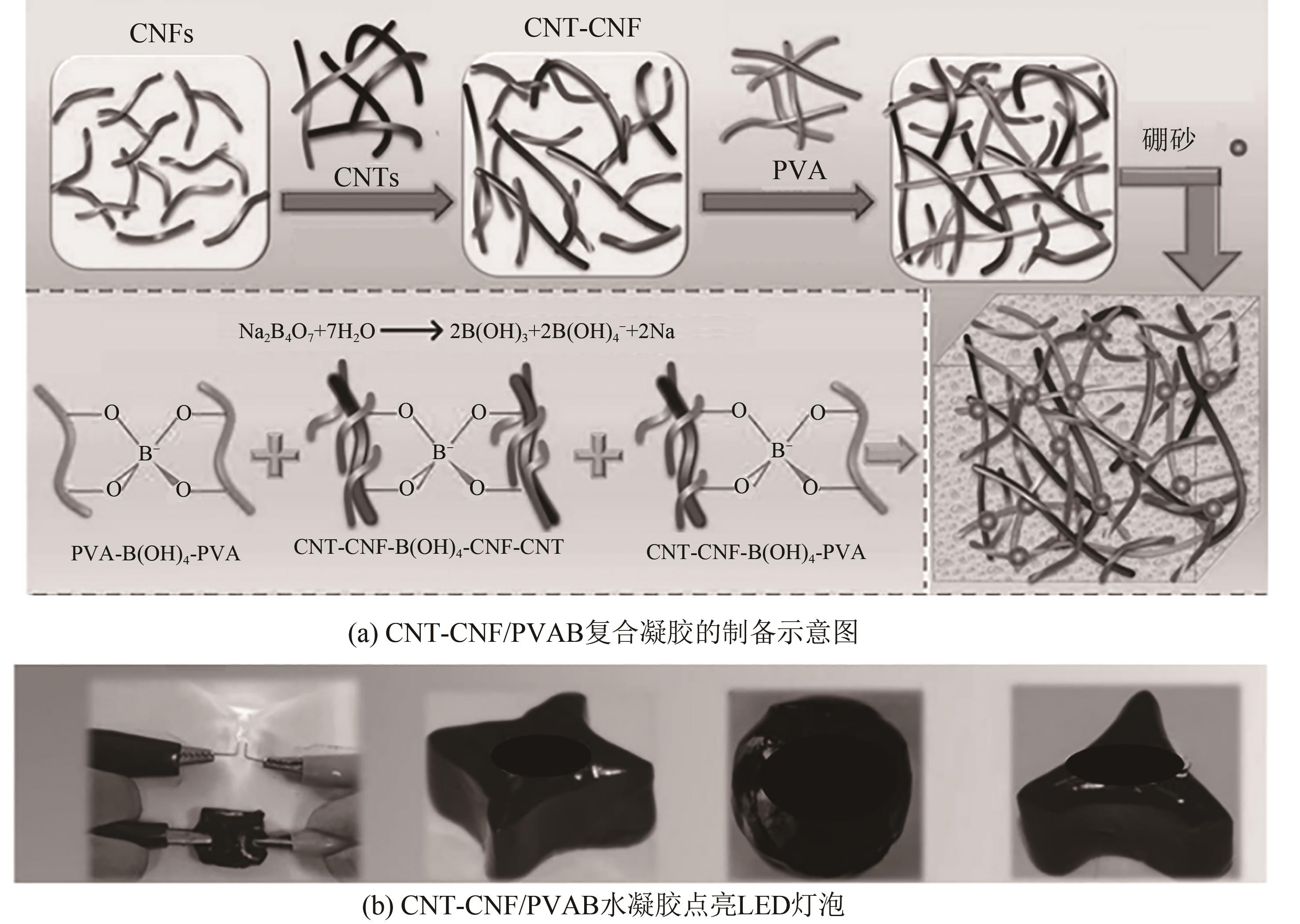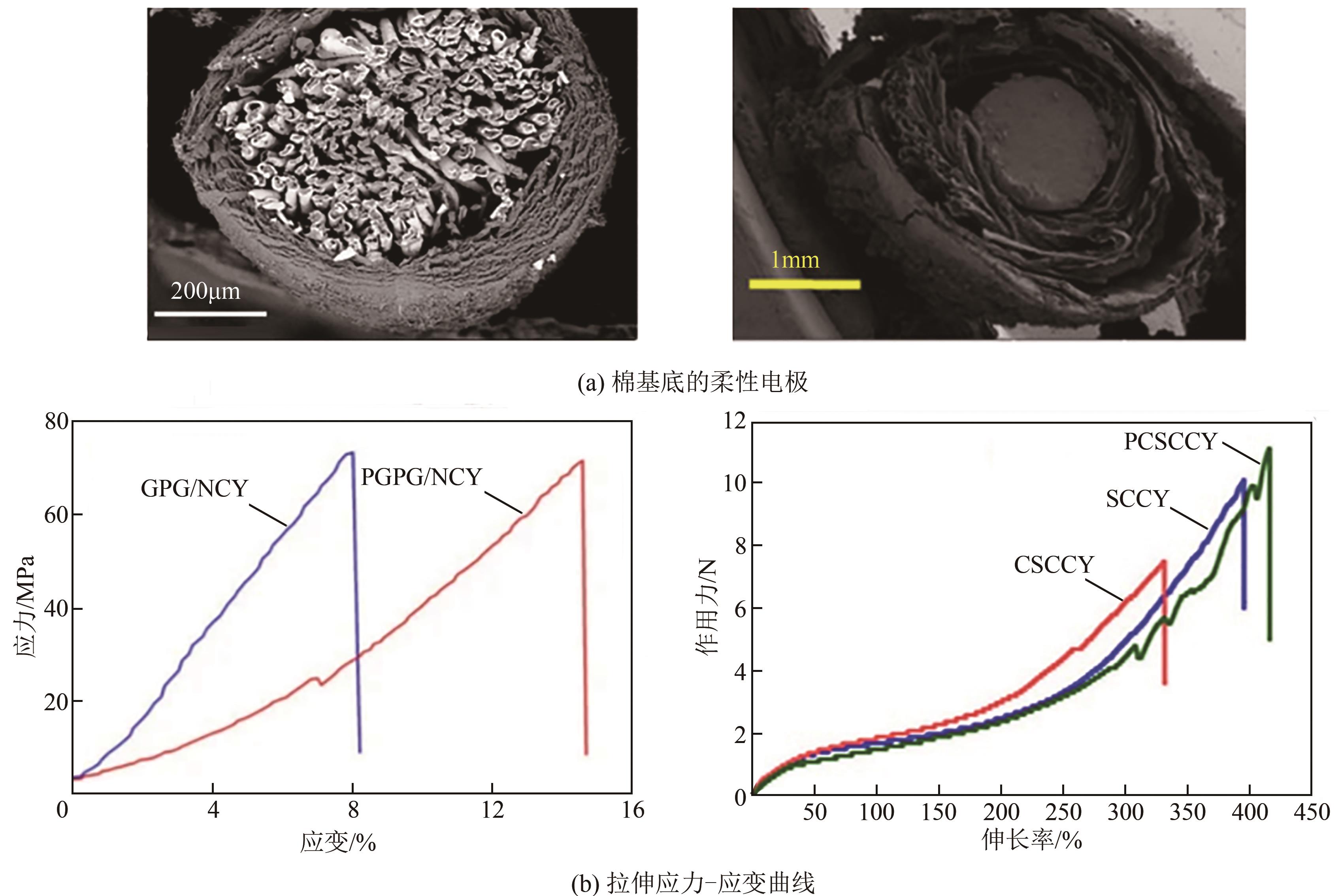Chemical Industry and Engineering Progress ›› 2023, Vol. 42 ›› Issue (2): 884-896.DOI: 10.16085/j.issn.1000-6613.2022-0773
• Materials science and technology • Previous Articles Next Articles
Research progress in carbon materials for flexible supercapacitors
TIAN Tian( ), LEI Xiping(
), LEI Xiping( ), YU Ting, FAN Kai, SONG Xiaoqi, ZHU Hang
), YU Ting, FAN Kai, SONG Xiaoqi, ZHU Hang
- School of Materials Science and Engineering, Xi’an University of Architecture and Technology, Xi’an 710055, Shaanxi, China
-
Received:2022-04-27Revised:2022-06-27Online:2023-03-13Published:2023-02-25 -
Contact:LEI Xiping
碳材料在柔性超级电容器中的研究进展
- 西安建筑科技大学材料科学与工程学院,陕西 西安 710055
-
通讯作者:雷西萍 -
作者简介:田甜(1998—),女,硕士研究生,研究方向为超级电容器。E-mail: tian3976@163.com。 -
基金资助:超级电容器电极材料设计与应用团队建设项目
CLC Number:
Cite this article
TIAN Tian, LEI Xiping, YU Ting, FAN Kai, SONG Xiaoqi, ZHU Hang. Research progress in carbon materials for flexible supercapacitors[J]. Chemical Industry and Engineering Progress, 2023, 42(2): 884-896.
田甜, 雷西萍, 于婷, 樊凯, 宋晓琪, 朱航. 碳材料在柔性超级电容器中的研究进展[J]. 化工进展, 2023, 42(2): 884-896.
share this article
Add to citation manager EndNote|Ris|BibTeX
URL: https://hgjz.cip.com.cn/EN/10.16085/j.issn.1000-6613.2022-0773
| 1 | DU Yongquan, XIAO Peng, YUAN Jian, et al. Research progress of graphene-based materials on flexible supercapacitors[J]. Coatings, 2020, 10(9): 892. |
| 2 | DELBARI S A, GHADIMI L S, HADI R, et al. Transition metal oxide-based electrode materials for flexible supercapacitors: A review[J]. Journal of Alloys and Compounds, 2021, 857: 158281. |
| 3 | WANG Zifeng, ZHU Minshen, PEI Zengxia, et al. Polymers for supercapacitors: Boosting the development of the flexible and wearable energy storage[J]. Materials Science and Engineering R: Reports, 2020, 139: 100520. |
| 4 | ZHONG Cheng, DENG Yida, HU Wenbin, et al. A review of electrolyte materials and compositions for electrochemical supercapacitors[J]. Chemical Society Reviews, 2015, 44(21): 7484-7539. |
| 5 | PATEL K K, SINGHAL T, PANDEY V, et al. Evolution and recent developments of high performance electrode material for supercapacitors: A review[J]. Journal of Energy Storage, 2021, 44: 103366. |
| 6 | KIM Chan, CHOI Yeong Og, LEE Wanjin, et al. Supercapacitor performances of activated carbon fiber webs prepared by electrospinning of PMDA-ODA poly(amic acid) solutions[J]. Electrochimica Acta, 2004, 50(2/3): 883-887. |
| 7 | PUSHPARAJ V L, SHAIJUMON M M, KUMAR A, et al. Flexible energy storage devices based on nanocomposite paper[J]. Proceedings of the National Academy of Sciences of the United States of America, 2007, 104(34): 13574-13577. |
| 8 | HU L B, PASTA M, MANTIA F L, et al. Stretchable, porous, and conductive energy textiles[J]. Nano Letters, 2010, 10(2): 708-714. |
| 9 | CONWAY B E. Electrochemical supercapacitors: Scientific fundamentals and technological applications[M]. New York: Springer Science & Business Media, 2013: 14-482. |
| 10 | Eunho LIM, Changshin JO, LEE Jinwoo. A mini review of designed mesoporous materials for energy-storage applications: From electric double-layer capacitors to hybrid supercapacitors[J]. Nanoscale, 2016, 8(15): 7827-7833. |
| 11 | SIMON P, GOGOTSI Y. Materials for electrochemical capacitors[J]. Nature Materials, 2008, 7(11): 845-854. |
| 12 | WANG Yonggang, SONG Yanfang, XIA Yongyao. Electrochemical capacitors: Mechanism, materials, systems, characterization and applications[J]. Chemical Society Reviews, 2016, 45(21): 5925-5950. |
| 13 | LANG X Y, HIRATA A, FUJITA T, et al. Nanoporous metal/oxide hybrid electrodes for electrochemical supercapacitors[J]. Nature Nanotechnology, 2011, 6(4): 232-236. |
| 14 | YANG Wen, NI Mei, REN Xin, et al. Graphene in supercapacitor applications[J]. Current Opinion in Colloid & Interface Science, 2015, 20(5/6): 416-428. |
| 15 | LIN Shiying, MO Lanlan, WANG Feijun. One-step synthesis of O-self-doped honeycomb-like hierarchically porous carbons for supercapacitors[J]. Journal of Electrochemical Energy Conversion and Storage, 2022, 19(1): 011003. |
| 16 | BABIĆ B, KALUĐEROVIĆ B, VRAČAR L, et al. Characterization of carbon cryogel synthesized by sol-gel polycondensation and freeze-drying[J]. Carbon, 2004, 42(12/13): 2617-2624. |
| 17 | BO Zheng, LI Changwen, YANG Huachao, et al. Design of supercapacitor electrodes using molecular dynamics simulations[J]. Nano-Micro Letters, 2018, 10(2): 1-23. |
| 18 | PÉAN C, MERLET C, ROTENBERG B, et al. On the dynamics of charging in nanoporous carbon-based supercapacitors[J]. ACS Nano, 2014, 8(2): 1576-1583. |
| 19 | CHOI Hojin, YOON Hyeonseok. Nanostructured electrode materials for electrochemical capacitor applications[J]. Nanomaterials, 2015, 5(2): 906-936. |
| 20 | XU Kui, SHAO Hui, LIN Zifeng, et al. Computational insights into charge storage mechanisms of supercapacitors[J]. Energy & Environmental Materials, 2020, 3(3): 235-246. |
| 21 | BI Ruyi, MAO Dan, WANG Jiangyan, et al. Hollow nanostructures for surface/interface chemical energy storage application[J]. Acta Chimica Sinica, 2020, 78(11): 1200. |
| 22 | NOORI A, EL-KADY M F, RAHMANIFAR M S, et al. Towards establishing standard performance metrics for batteries, supercapacitors and beyond[J]. Chemical Society Reviews, 2019, 48(5): 1272-1341. |
| 23 | TRASATTI S, BUZZANCA G. Ruthenium dioxide: A new interesting electrode material. Solid state structure and electrochemical behaviour[J]. Journal of Electroanalytical Chemistry and Interfacial Electrochemistry, 1971, 29(2): A1-A5. |
| 24 | CHOI C, ASHBY D S, BUTTS D M, et al. Achieving high energy density and high power density with pseudocapacitive materials[J]. Nature Reviews Materials, 2020, 5(1): 5-19. |
| 25 | KEILBART N, OKADA Y, DABO I. Probing the pseudocapacitance and energy-storage performance of RuO2 facets from first principles[J]. Physical Review Materials, 2019, 3(8): 085405. |
| 26 | LIU Y, JIANG S P, SHAO Z. Intercalation pseudocapacitance in electrochemical energy storage: Recent advances in fundamental understanding and materials development[J]. Materials Today Advances, 2020, 7: 100072. |
| 27 | LOU Shuaifeng, CHENG Xinqun, WANG Long, et al. High-rate capability of three-dimensionally ordered macroporous T-Nb2O5 through Li+ intercalation pseudocapacitance[J]. Journal of Power Sources, 2017, 361: 80-86. |
| 28 | KONG Lingping, CAO Xiaodong, WANG Jitong, et al. Revisiting Li+ intercalation into various crystalline phases of Nb2O5 anchored on graphene sheets as pseudocapacitive electrodes[J]. Journal of Power Sources, 2016, 309: 42-49. |
| 29 | YANG Ben, SHE Yin, ZHANG Changgeng, et al. Nitrogen doped intercalation TiO2/TiN/Ti3C2T x nanocomposite electrodes with enhanced pseudocapacitance[J]. Nanomaterials, 2020, 10(2): 345. |
| 30 | SRIMUK P, KAASIK F, KRÜNER B, et al. MXene as a novel intercalation-type pseudocapacitive cathode and anode for capacitive deionization[J]. Journal of Materials Chemistry A, 2016, 4(47): 18265-18271. |
| 31 | HAN Xue, MENG Qi, WAN Xin, et al. Intercalation pseudocapacitive electrochemistry of Nb-based oxides for fast charging of lithium-ion batteries[J]. Nano Energy, 2021, 81: 105635. |
| 32 | MUZAFFAR A, AHAMED M B, DESHMUKH K, et al. A review on recent advances in hybrid supercapacitors: Design, fabrication and applications[J]. Renewable and Sustainable Energy Reviews, 2019, 101: 123-145. |
| 33 | 黄士飞, 帖炟, 佟琦, 等. 基于超级电容的混合储能器件研究现状及展望[J]. 自然杂志, 2017, 39(4): 265-282. |
| HUANG Shifei, Da TIE, TONG Qi, et al. Advances and prospects for supercapacitor-based hybrid energy storage devices[J]. Chinese Journal of Nature, 2017, 39(4): 265-282. | |
| 34 | SHINDE S K, KIM D Y, KUMAR M, et al. MOFs-graphene composites synthesis and application for electrochemical supercapacitor: A review[J]. Polymers, 2022, 14(3): 511. |
| 35 | FANG Haiqiu, LI Dezhi, ZHAO Mingyao, et al. Research progress and prospect of hybrid supercapacitors as boosting the performance[J]. Energy Sources, Part A: Recovery, Utilization, and Environmental Effects, 2022: 1-18. |
| 36 | LIU Qiang, YANG Junjie, LUO Xiaogang, et al. Fabrication of a fibrous MnO2@MXene/CNT electrode for high-performance flexible supercapacitor[J]. Ceramics International, 2020, 46(8): 11874-11881. |
| 37 | ZHANG Li, TIAN Yao, SONG Chunxiao, et al. Study on preparation and performance of flexible all-solid-state supercapacitor based on nitrogen-doped RGO/CNT/MnO2 composite fibers[J]. Journal of Alloys and Compounds, 2021, 859: 157816. |
| 38 | XU Yanfang, YAN Yushan, LU Weibang, et al. High-performance flexible asymmetric fiber-shaped supercapacitor based on CF/PPy and CNT/MnO2 composite electrodes[J]. ACS Applied Energy Materials, 2021, 4(10): 10639-10645. |
| 39 | ISLAM M S, FAISAL S N, TONG L Y, et al. N-doped reduced graphene oxide (rGO) wrapped carbon microfibers as binder-free electrodes for flexible fibre supercapacitors and sodium-ion batteries[J]. Journal of Energy Storage, 2021, 37: 102453. |
| 40 | CHEN Shuai, JIANG Hao, CHENG Qilin, et al. Amorphous vanadium oxides with metallic character for asymmetric supercapacitors[J]. Chemical Engineering Journal, 2021, 403: 126380. |
| 41 | YIN Xuemin, LI Hejun, YUAN Ruimei, et al. Hierarchical self-supporting sugar gourd-shape MOF-derived NiCo2O4 hollow nanocages@SiC nanowires for high-performance flexible hybrid supercapacitors[J]. Journal of Colloid and Interface Science, 2021, 586: 219-232. |
| 42 | YIN Xuemin, LI Hejun, YUAN Ruimei, et al. Metal-organic framework derived hierarchical NiCo2O4 triangle nanosheet arrays@SiC nanowires network/carbon cloth for flexible hybrid supercapacitors[J]. Journal of Materials Science & Technology, 2021, 81: 162-174. |
| 43 | WU Yatao, CHEN Hao, LU Yingzhuo, et al. Rational design of cobalt-nickel double hydroxides for flexible asymmetric supercapacitor with improved electrochemical performance[J]. Journal of Colloid and Interface Science, 2021, 581: 455-464. |
| 44 | ZHAO Wei, ZHENG Yiwei, CUI Liang, et al. MOF derived Ni-Co-S nanosheets on electrochemically activated carbon cloth via an etching/ion exchange method for wearable hybrid supercapacitors[J]. Chemical Engineering Journal, 2019, 371: 461-469. |
| 45 | YAN Shengxue, LUO Shaohua, FENG Jian, et al. Rational design of flower-like FeCo2S4/reduced graphene oxide films: Novel binder-free electrodes with ultra-high conductivity flexible substrate for high-performance all-solid-state pseudocapacitor[J]. Chemical Engineering Journal, 2020, 381: 122695. |
| 46 | YOU Mingyu, ZHANG Wenjing, YAN Xuehua, et al. V2O5 nanosheets assembled on 3D carbon fiber felt as a free-standing electrode for flexible asymmetric supercapacitor with remarkable energy density[J]. Ceramics International, 2021, 47(3): 3337-3345. |
| 47 | WANG Qiufan, RAN Xuan, SHAO Wenke, et al. High performance flexible supercapacitor based on metal-organic-framework derived CoSe2 nanosheets on carbon nanotube film[J]. Journal of Power Sources, 2021, 490: 229517. |
| 48 | XIE Yibing, CHEN Yucheng. Experimental and computational investigation of Cu-N coordination bond strengthened polyaniline for stable energy storage[J]. Journal of Materials Science, 2021, 56(16): 10135-10153. |
| 49 | 周亚丽. 壳聚糖生物质碳基电极材料的制备及其电化学性能研究[D]. 西安: 西安建筑科技大学, 2021. |
| ZHOU Yali. Study on preparation and electrochemical properties of chitosan biomass carbon based electrode materials[D]. Xi’an: Xi’an University of Architecture and Technology, 2021. | |
| 50 | MA Yu, LIU Qiao, LI Weijun, et al. Ultralight and robust carbon nanofiber aerogels for advanced energy storage[J]. Journal of Materials Chemistry A, 2021, 9(2): 900-907. |
| 51 | LIU Huayu, XU Ting, LIANG Qidi, et al. Compressible cellulose nanofibrils/reduced graphene oxide composite carbon aerogel for solid-state supercapacitor[J]. Advanced Composites and Hybrid Materials, 2022, 5(2): 1168-1179. |
| 52 | CHEBIL A, KUZGUN O, DRIDI C, et al. High power density supercapacitor devices based on nickel foam-coated rGO/MnCo2O4 nanocomposites[J]. Ionics, 2020, 26(11): 5725-5735. |
| 53 | DENG Bowen, YANG Yi, LIU Yuxin, et al. Dipping fabrication of rHGO@NiO@NF flexible supercapacitor electrode and its potential in bendable electronic devices[J]. Electrochimica Acta, 2021, 399: 139359. |
| 54 | ZHANG Zhijia, REN Zenying, ZHANG Shaofei, et al. High-yielding carbon nanofibers grown on NIPS-derived porous nickel as a flexible electrode for supercapacitors[J]. Materials Chemistry Frontiers, 2020, 4(10): 2976-2981. |
| 55 | VARAKIN I N, STEPANOV A B, MENUKHOV V V. Douvble-layer capacitor: US5986876A[P]. 1999-11-16 |
| 56 | ZHOU Ting, ZHANG Wenjun, FU Hao, et al. Flexible synthesis of high-performance electrode materials of N-doped carbon coating MnO nanowires for supercapacitors[J]. Nanotechnology, 2021, 33(8): ac394b. |
| 57 | LIANG Jing, TIAN Bin, LI Shuaiqi, et al. All-printed MnHCF-MnO x -based high-performance flexible supercapacitors[J]. Advanced Energy Materials, 2020, 10(12): 2000022. |
| 58 | ZHOU Yihao, MALESKI K, ANASORI B, et al. Ti3C2T x MXene-reduced graphene oxide composite electrodes for stretchable supercapacitors[J]. ACS Nano, 2020, 14(3): 3576-3586. |
| 59 | ZHOU Tianzhu, WU Chao, WANG Yanlei, et al. Super-tough MXene-functionalized graphene sheets[J]. Nature Communications, 2020, 11(1): 2077. |
| 60 | ZHANG P, ZHU Q Z, SOOMRO R A, et al. In situ ice template approach to fabricate 3D flexible MXene film-based electrode for high performance supercapacitors[J]. Advanced Functional Materials, 2020, 30(47): 2000922. |
| 61 | ZHANG Chenjun, LI Hui, HUANG Aoming, et al. Rational design of a flexible CNTs@PDMS film patterned by bio-inspired templates as a strain sensor and supercapacitor[J]. Small, 2019, 15(18): e1805493. |
| 62 | Jianwei BEN, SONG Zhiyuan, LIU Xinke, et al. Fabrication and electrochemical performance of PVA/CNT/PANI flexible films as electrodes for supercapacitors[J]. Nanoscale Research Letters, 2020, 15(1): 151. |
| 63 | JYOTHIBASU J P, LEE R H. Green synthesis of polypyrrole tubes using curcumin template for excellent electrochemical performance in supercapacitors[J]. Journal of Materials Chemistry A, 2020, 8(6): 3186-3202. |
| 64 | BAI Yang, LIU Rong, LI Enyuan, et al. Graphene/carbon nanotube/bacterial cellulose assisted supporting for polypyrrole towards flexible supercapacitor applications[J]. Journal of Alloys and Compounds, 2019, 777: 524-530. |
| 65 | YU Ting, LEI Xiping, ZHOU Yali, et al. Ti3C2T x MXenes reinforced PAA/CS hydrogels with self-healing function as flexible supercapacitor electrodes[J]. Polymers for Advanced Technologies, 2021, 32(8): 3167-3179. |
| 66 | HAN Jingquan, WANG Huixiang, YUE Yiying, et al. A self-healable and highly flexible supercapacitor integrated by dynamically cross-linked electro-conductive hydrogels based on nanocellulose-templated carbon nanotubes embedded in a viscoelastic polymer network[J]. Carbon, 2019, 149: 1-18. |
| 67 | HAO Baowei, DENG Zhongmin, BI Shuguang, et al. In situ polymerization of pyrrole on CNT/cotton multifunctional composite yarn for supercapacitors[J]. Ionics, 2021, 27(1): 279-288. |
| 68 | RAJ C J, MANIKANDAN R, CHO W J, et al. High-performance flexible and wearable planar supercapacitor of manganese dioxide nanoflowers on carbon fiber cloth[J]. Ceramics International, 2020, 46(13): 21736-21743. |
| 69 | YANG Yuan, CHEN Zeqi, YE Dezhan, et al. Polypyrrole/CNT/cotton composite yarn supercapacitor for wearable electronics[J]. Fibers and Polymers, 2022, 23(2): 327-334. |
| 70 | ZHAO Xu, LI Wanwan, LI Fang, et al. Wearable yarn supercapacitors coated with twisted PPy@GO nanosheets and PPy@PAN-GO nanofibres[J]. Journal of Materials Science, 2021, 56(32): 18147-18161. |
| 71 | LIANG Chunliu, ZANG Limin, SHI Fangfang, et al. High-performance cotton fabric-based supercapacitors consisting of polypyrrole/Ag/graphene oxide nanocomposite prepared via UV-induced polymerization[J]. Cellulose, 2022, 29(4): 2525-2537. |
| 72 | CAI Guangming, HAO Baowei, LUO Lei, et al. Highly stretchable sheath-core yarns for multifunctional wearable electronics[J]. ACS Applied Materials & Interfaces, 2020, 12(26): 29717-29727. |
| 73 | COSTA R S, GUEDES A, PEREIRA A M, et al. Fabrication of all-solid-state textile supercapacitors based on industrial-grade multi-walled carbon nanotubes for enhanced energy storage[J]. Journal of Materials Science, 2020, 55(23): 10121-10141. |
| 74 | ZHANG Chuanjie, TIAN Jiaxin, RAO Weida, et al. Polypyrrole@metal-organic framework (UIO-66)@cotton fabric electrodes for flexible supercapacitors[J]. Cellulose, 2019, 26(5): 3387-3399. |
| 75 | LI Zengqing, TIAN Mingwei, SUN Xuantong, et al. Flexible all-solid planar fibrous cellulose nonwoven fabric-based supercapacitor via capillarity-assisted graphene/MnO2 assembly[J]. Journal of Alloys and Compounds, 2019, 782: 986-994. |
| 76 | Jingchun LYU, ZHANG Linping, ZHONG Yi, et al. High-performance polypyrrole coated knitted cotton fabric electrodes for wearable energy storage[J]. Organic Electronics, 2019, 74: 59-68. |
| 77 | WANG Bo, LI Zezhao, YIN Yunjie, et al. Center and multi-points current collecting for improving capacitances of rectangular polypyrrole/knitted cotton fabric-based supercapacitor[J]. Journal of Power Sources, 2021, 481: 228824. |
| 78 | LI Kang, LIU Xuanli, CHEN Song, et al. A flexible solid-state supercapacitor based on graphene/polyaniline paper electrodes[J]. Journal of Energy Chemistry, 2019, 32: 166-173. |
| 79 | Peng LYU, SONG Lingxia, LI Yue, et al. Hybrid ternary rice paper/polypyrrole ink/pen ink nanocomposites as components of flexible supercapacitors[J]. International Journal of Hydrogen Energy, 2021, 46(24): 13219-13229. |
| 80 | KUMAR S, PANDEY C M, HATAMIE A, et al. Nanomaterial-modified conducting paper: Fabrication, properties, and emerging biomedical applications[J]. Global Challenges, 2019, 3(12): 1900041. |
| 81 | PASCHOALINO W J, KOGIKOSKI S JR, BARRAGAN J T C, et al. Emerging considerations for the future development of electrochemical paper-based analytical devices[J]. ChemElectroChem, 2019, 6(1): 10-30. |
| 82 | SOAM A, KUMAR R, C M, et al. Development of paper-based flexible supercapacitor: Bismuth ferrite/graphene nanocomposite as an active electrode material[J]. Journal of Alloys and Compounds, 2020, 813: 152145. |
| 83 | KLEM M D S, MORAIS R M, RUBIRA R J G, et al. Paper-based supercapacitor with screen-printed poly(3,4-ethylene dioxythiophene)-poly(styrene sulfonate)/multiwall carbon nanotube films actuating both as electrodes and current collectors[J]. Thin Solid Films, 2019, 669: 96-102. |
| 84 | ZHANG Leicong, YU Xuecheng, ZHU Pengli, et al. Laboratory filter paper as a substrate material for flexible supercapacitors[J]. Sustainable Energy & Fuels, 2018, 2(1): 147-154. |
| 85 | JIAO Shasha, LI Tiehu, XIONG Chuanyin, et al. A facile method to prepare silver doped graphene combined with polyaniline for high performances of filter paper based flexible electrode[J]. Nanomaterials, 2019, 9(10): 1434. |
| [1] | WANG Shuaiqing, YANG Siwen, LI Na, SUN Zhanying, AN Haoran. Research progress on element doped biomass carbon materials for electrochemical energy storage [J]. Chemical Industry and Engineering Progress, 2023, 42(8): 4296-4306. |
| [2] | CHEN Fei, LIU Chengbao, CHEN Feng, QIAN Junchao, QIU Yongbin, MENG Xianrong, CHEN Zhigang. Research progress on graphitic carbon nitride based materials for supercapacitor [J]. Chemical Industry and Engineering Progress, 2023, 42(5): 2566-2576. |
| [3] | WANG Xue, XU Qiyong, ZHANG Chao. Hydrothermal carbonization of the lignocellulosic biomass and application of the hydro-char [J]. Chemical Industry and Engineering Progress, 2023, 42(5): 2536-2545. |
| [4] | LIU Jing, LIN Lin, ZHANG Jian, ZHAO Feng. Research progress in pore size regulation and electrochemical performance of biomass-based carbon materials [J]. Chemical Industry and Engineering Progress, 2023, 42(4): 1907-1916. |
| [5] | CAI Jiangtao, HOU Liuhua, LAN Yujin, ZHANG Chenchen, LIU Guoyang, ZHU Youyu, ZHANG Jianlan, ZHAO Shiyong, ZHANG Yating. Preparation of pitch-based porous carbon materials and application in supercapacitors [J]. Chemical Industry and Engineering Progress, 2023, 42(4): 1895-1906. |
| [6] | CHEN Chongming, ZENG Siming, LUO Xiaona, SONG Guosheng, HAN Zhongge, YU Jinxing, SUN Nannan. Preparation and performance of carbon supported potassium-based CO2 adsorbent derived from hyper-cross linked polymers [J]. Chemical Industry and Engineering Progress, 2023, 42(3): 1540-1550. |
| [7] | LIU Dan, FAN Yunjie, WANG Huimin, YAN Zheng, LI Pengfei, LI Jiacheng, CAO Xuebo. High value-added functional porous carbon materials from waste PET and their applications [J]. Chemical Industry and Engineering Progress, 2023, 42(2): 969-984. |
| [8] | ZHUO Zuyou, SONG Shengnan, HUANG Mingjie, YANG Xuan, LU Beili, CHEN Yandan. Preparation of wheat flour-based hierarchical porous carbon with ultra large specific surface area by synergistic activation of potassium oxalate-urea and its electrochemical energy storage performance [J]. Chemical Industry and Engineering Progress, 2023, 42(2): 925-933. |
| [9] | LI Xing, HUANG Hongyu, OSAKA Yugo, HUHE Taoli, XIAO Linfa, LI Jun. Study on the influencing factors of the adsorption performance of carbon materials for the sulfur dioxide removal [J]. Chemical Industry and Engineering Progress, 2022, 41(9): 4963-4972. |
| [10] | LONG Yinying, YANG Jian, GUAN Min, YANG Yiluo, CHENG Zhengbai, CAO Haibing, LIU Hongbin, AN Xingye. Research progress of lignin-based materials in electrode materials for hybrid supercapacitors [J]. Chemical Industry and Engineering Progress, 2022, 41(9): 4855-4865. |
| [11] | XU Hu, GUO Hongkai, CHAI Changsheng, HAO Xiangzhong, YANG Ziyuan, XU Weijun. Carbon fiber materials used for the electrode of electro-Fenton system: a critical review [J]. Chemical Industry and Engineering Progress, 2022, 41(7): 3707-3718. |
| [12] | WU Chuanpeng, LI Chuankun, YANG Zhe, GOU Chengdong, GAO Xinjiang. Research progress of SO2 removal by solid adsorbents [J]. Chemical Industry and Engineering Progress, 2022, 41(7): 3840-3854. |
| [13] | XUE Lijing, FEI Xing, LIU Jianglin, WU Linjun, QIU Zhongjie, XU Quanzhou, ZHONG Xiaowen, LIN Xuliang, QIN Yanlin. Research progress on the preparation and application of lignin-based carbon catalysts [J]. Chemical Industry and Engineering Progress, 2022, 41(5): 2441-2450. |
| [14] | XIONG Zhe, DENG Wei, LIU Jia, WANG Xuepeng, XU Jun, JIANG Long, SU Sheng, WANG Yi, HU Song, XIANG Jun. Research progress in coke formation characteristics of bio-oil during its non-catalytic thermal conversion process [J]. Chemical Industry and Engineering Progress, 2022, 41(4): 1802-1813. |
| [15] | HU Tingyuan, LI Pingfan, WANG Wei, LIU Zhuang, JU Xiaojie, XIE Rui, CHU Liangyin. Research pogress of functional hydrogel materials for soft supercapacitors [J]. Chemical Industry and Engineering Progress, 2022, 41(3): 1578-1593. |
| Viewed | ||||||
|
Full text |
|
|||||
|
Abstract |
|
|||||
